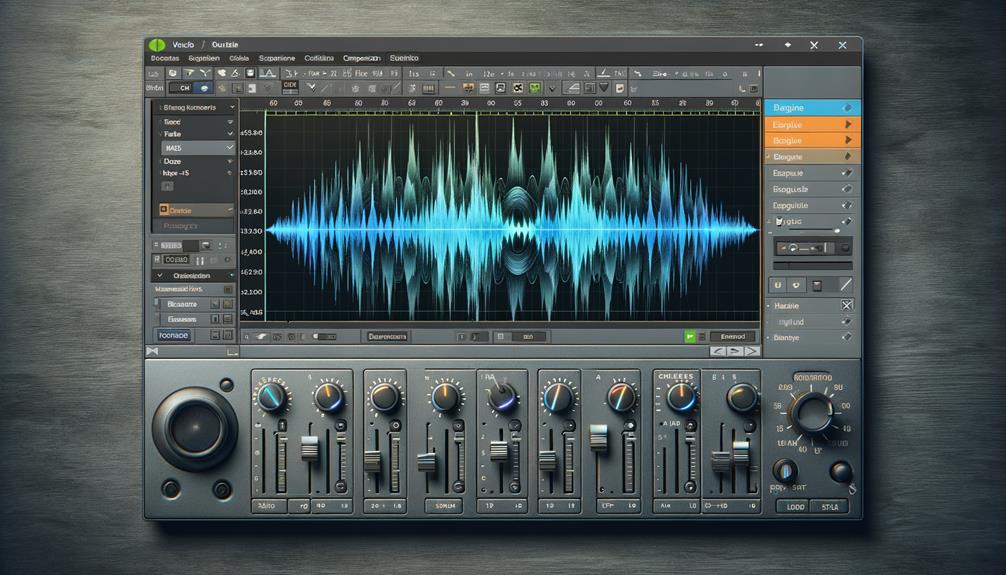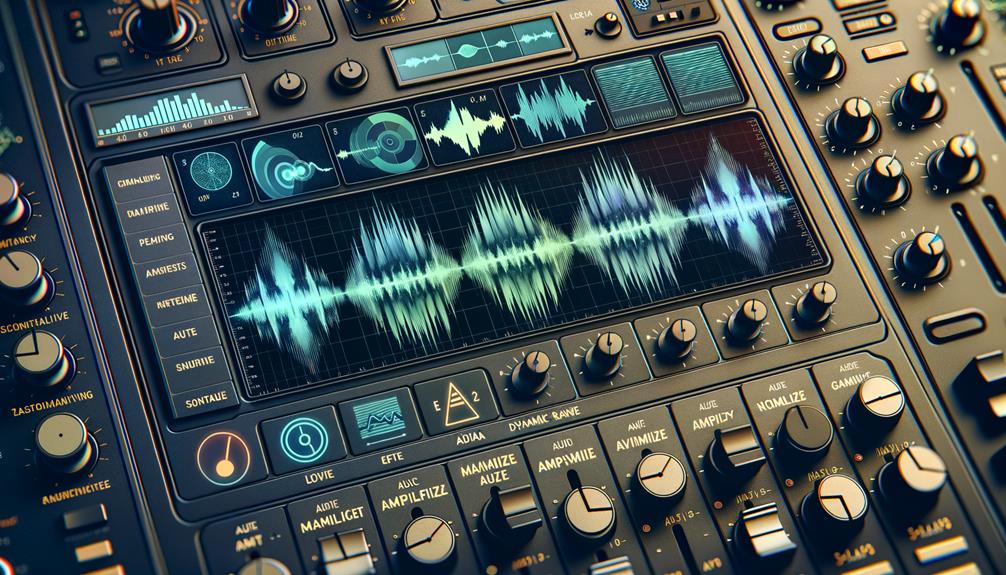No products in the cart.
Tired of grappling with the distracting hums and hisses in your recorded audio? Look no further. With a few simple steps, you can transform your raw audio files into polished, professional-sounding recordings.
Whether it’s eliminating background noise, banishing pesky clicks and pops, or enhancing vocal clarity, Audacity offers a suite of tools to help you achieve pristine audio. But there’s more to it than just hitting a button – understanding how to wield these tools effectively is key to achieving the results you desire.
Ready to take your audio quality to the next level?
Contents
hide
Key Takeaways
- Audacity’s Noise Reduction tool effectively removes constant sources of noise such as fan hiss and fridge hum.
- Clicks and pops in audio recordings can be eliminated using the Click Removal effect in Audacity.
- Techniques like Noise Reduction, Noise Gate, and Notch Filter can enhance vocal clarity and presence in recordings.
- The equalization tool in Audacity can be used to adjust the frequency levels of audio for a balanced sound.
Understanding Audacity’s Noise Reduction Tool
When working with Audacity’s Noise Reduction tool, you can effectively remove constant sources of noise such as fan hiss, fridge hum, and various other unwanted sounds.
To begin the noise reduction process, select a portion of the audio that contains only the background noise you want to remove. Then, navigate to the ‘Effects’ menu, choose ‘Noise Reduction’, and click on ‘Get noise profile’. This action captures the noise profile, which is essential for the tool to identify and reduce the unwanted sound effectively.
After obtaining the noise profile, you can adjust the noise reduction settings according to your preferences. It’s crucial to find the right balance, as setting the sensitivity too low or using an inaccurate noise profile can result in artifacts in the audio.
To preview the sound that will be removed, you can use the ‘Residue’ toggle. Once you’re satisfied with the noise reduction settings, you can apply the effect immediately using the shortcut Ctrl+R (Cmd+R).
This meticulous process ensures that the noise level in your audio is significantly reduced, resulting in cleaner and more polished audio editing.
Eliminating Clicks and Pops in Your Audio
After successfully reducing constant sources of noise using Audacity’s Noise Reduction tool, the next step is to address the presence of clicks and pops in your audio recordings. Clicks and pops can often be caused by dust, scratches, or other imperfections on the recording medium.
To eliminate these, select the section of the track where the clicks and pops are present. Use a free audio repair tool like the Click Removal effect in Audacity.
Firstly, highlight the section of the track that contains the clicks and pops. Next, navigate to the Effect menu and select Click Removal. Adjust the settings to remove the unwanted noise without affecting the overall sound quality of the audio file.
It’s important to preview the changes and fine-tune the settings to ensure that the clicks and pops are effectively eliminated.
Enhancing Vocal Clarity and Presence

To enhance vocal clarity and presence in your recordings, employ techniques such as Noise Reduction, Noise Gate, and Notch Filter to effectively address different types of noise and improve the overall quality of the audio. Each of these tools plays a crucial role in enhancing the audio quality and ensuring a professional sound track.
| Technique | Description |
|---|---|
| Noise Reduction | Removes constant noise sources like fan hiss and fridge hum, enhancing vocal clarity. |
| Noise Gate | Achieves a cleaner result with less aggressive noise reduction settings, enhancing vocal presence. |
| Notch Filter | Fully removes harmonics or overtones, further enhancing vocal clarity. |
Implementing these techniques in Audacity can significantly improve the clarity and presence of vocals in your recordings. By addressing different types of noise and utilizing the appropriate effects, you can elevate the quality of your audio and deliver a polished sound track.
Utilizing Equalization for Balanced Sound
Utilize the equalization tool in Audacity to precisely adjust the frequency levels of your audio, achieving a balanced and polished sound output.
When using Audacity, navigate to the Effect menu and select Equalization to access the equalization tool. Once there, choose a suitable equalization profile from the drop-down menu to adjust the audio frequencies.
This allows you to tailor the sound to your preferences, compensating for any loss of quality caused by noise removal or other editing processes. Before applying the equalization effect, it’s essential to preview the changes to ensure the desired balanced sound.
This process not only enhances the overall quality of the audio track but also ensures that the volume and frequencies are balanced and optimized for a more professional sound output.
Mastering Audio With Amplification and Normalization


When mastering audio with amplification and normalization, it is crucial to carefully balance the volume levels and ensure a consistent amplitude throughout the recording. Amplification increases the volume of selected audio sections, making them louder and more audible, while normalization brings the entire recording to a consistent level of amplitude, avoiding overly quiet or loud segments. These techniques are essential for balancing and optimizing the overall volume of an audio track. However, when applying amplification, it’s important to be mindful of potential distortion or clipping that may occur if the volume is raised too high. Normalization, on the other hand, is particularly useful for achieving a balanced and consistent audio level across different parts of the recording. Here’s a breakdown of the process in Audacity:
| Step | Description | How to Use |
|---|---|---|
| 1 | Amplification | Select the audio section to amplify, go to the ‘Effect’ menu, and choose ‘Amplify’. Adjust the amplification level as needed. |
| 2 | Normalization | Go to the ‘Effect’ menu and select ‘Normalize’. Choose the desired peak amplitude and click ‘OK’ to apply normalization to the entire audio file. |
| 3 | Balancing | Use the amplification and normalization tools iteratively to balance the audio’s overall volume and ensure consistent amplitude throughout the track. |
Frequently Asked Questions
How Do I Improve Sound Quality in Audacity?
To improve sound quality in Audacity, start by using noise reduction to eliminate background noise. Then, apply equalization tips for balancing frequencies, compression techniques to control dynamics, volume normalization, and vocal clarity enhancement for professional audio editing tricks.
How Do You Clean up Muffled Audio in Audacity?
To clean up muffled audio in Audacity, start by using noise reduction to remove background noise. Then apply equalization tips, compression techniques, de-essing methods, and remove distortion to enhance vocal clarity and achieve high-quality audio recordings.
How Do I Make My Audio Clearer?
To make your audio clearer, start by using noise reduction to eliminate background noise. Enhance clarity with equalization techniques and vocal enhancement. Follow up with de-essing and audio polishing for a complete audio restoration.
How Do I Clean up My Audio Recording?
To clean up your audio recording, start with noise reduction to eliminate background noise. Use audio restoration, equalization techniques, and notch filters to remove unwanted frequencies. Prevent clipping and enhance vocals for overall audio enhancement.
Conclusion
In conclusion, mastering the use of Audacity’s Noise Reduction Tool can greatly improve the quality of your audio recordings. By eliminating unwanted background noise, clicks, and pops, as well as enhancing vocal clarity and presence through equalization, you can achieve a professional and balanced sound.
Remember to always use accurate noise profiles and adjust reduction settings carefully to avoid introducing artifacts. With practice and attention to detail, you can clean up audio in Audacity effectively.




